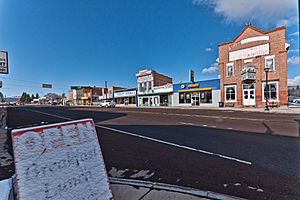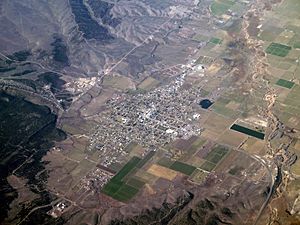Panguitch, Utah facts for kids
Quick facts for kids
Panguitch, Utah
|
|
|---|---|

Panguitch Main Street, April 2010
|
|

Location in Garfield County and state of Utah
|
|
| Country | United States |
| State | Utah |
| County | Garfield |
| Settled | 1864 |
| Incorporated | June 10, 1899 |
| Named for | Southern Paiute for "big fish" |
| Area | |
| • Total | 3.08 sq mi (7.99 km2) |
| • Land | 3.08 sq mi (7.99 km2) |
| • Water | 0.00 sq mi (0.00 km2) |
| Elevation | 6,624 ft (2,019 m) |
| Population
(2020)
|
|
| • Total | 1,725 |
| • Density | 545.40/sq mi (210.60/km2) |
| Time zone | UTC−7 (Mountain (MST)) |
| • Summer (DST) | UTC−6 (MDT) |
| ZIP code |
84759
|
| Area code(s) | 435 |
| FIPS code | 49-57740 |
| GNIS feature ID | 1444170 |
Panguitch is a city in Garfield County, Utah, United States. It is also the county seat, which means it is the main town for the county's government. In 2020, about 1,725 people lived there.
The name Panguitch comes from a Southern Paiute word. It means "Big Fish." This name probably came from the many rainbow trout found in the nearby lakes all year long.
Contents
Exploring Panguitch's Location and Surroundings
Panguitch is located on the western side of Garfield County. It sits in the valley of the Sevier River.
U.S. Route 89 goes right through the middle of the city. This road leads north to Junction and south to Orderville. Another road, Utah State Route 143, goes southwest from Panguitch. It leads to Panguitch Lake in Dixie National Forest.
The city covers an area of about 7.99 square kilometers (3.08 square miles). All of this area is land.
Panguitch's Climate: Hot Days, Cold Nights
Panguitch has a cool semi-arid climate. This means it gets hot afternoons and cold mornings in the summer. Winters are cold and dry. Because it is high up and fairly far north, mornings are often cold all year. It freezes for most of the year.
Even though winters are cold, they are very dry. This means there isn't much snowfall. Most of the rain happens from July to October. This is during the North American Monsoon season.
A Look Back at Panguitch's History
Panguitch was first settled in March 1864. A man named Jens Nielsen led 54 families to the Sevier River. They came from Parowan and Beaver.
Because Panguitch is high up (about 2,012 meters or 6,600 feet), winter came early. Most of their first crops were killed by frost. Seven men had to leave to find food from other towns. Heavy snow made them leave their wagons. They finished their trip on foot. They reportedly laid quilts on the snow to walk.
Due to the Black Hawk War, the settlers left in May 1865. Five years later, in 1871, new settlers arrived. They built a fort and lived there. They grew a lot of grain and built a grist mill. They also cut wood from the forests. They used sawmills and shingle mills.
They had a tannery to make leather from local cattle. They also used kilns to make rose-colored bricks from local clay. Workers were paid in these bricks. They used them to build their homes. You can still see these unique brick houses in Panguitch today.
Panguitch officially became a city in 1899. A social hall was built in 1900. It burned down in 1920. A new one was built, and it is now the Panguitch Playhouse.
The Panguitch Indian School operated from 1904 to 1909. It mainly housed Paiute children. Students as young as six were taken from their tribes. They were forced to live at the school.
For a long time, timber and livestock were important industries. After World War I, things changed. Now, tourism is a big part of the local economy. This is because of places like Bryce Canyon National Park.
In 2007, the entire town was named the Panguitch Historic District. This means it is a special place with important history.
Population and People of Panguitch
| Historical population | |||
|---|---|---|---|
| Census | Pop. | %± | |
| 1880 | 846 | — | |
| 1890 | 1,015 | 20.0% | |
| 1900 | 883 | −13.0% | |
| 1910 | 1,338 | 51.5% | |
| 1920 | 1,473 | 10.1% | |
| 1930 | 1,541 | 4.6% | |
| 1940 | 1,979 | 28.4% | |
| 1950 | 1,501 | −24.2% | |
| 1960 | 1,435 | −4.4% | |
| 1970 | 1,318 | −8.2% | |
| 1980 | 1,343 | 1.9% | |
| 1990 | 1,444 | 7.5% | |
| 2000 | 1,623 | 12.4% | |
| 2010 | 1,520 | −6.3% | |
| 2020 | 1,725 | 13.5% | |
In 2020, the population of Panguitch was 1,725 people.
Getting Around Panguitch
U.S. Highway 89 goes through Panguitch. It connects the city to Circleville in the north and Kanab in the south. Utah State Route 143 goes south from Panguitch to Panguitch Lake.
Famous People from Panguitch
- Wayne Owens, a Democratic Congressman who was born in Panguitch.
See also
 In Spanish: Panguitch (Utah) para niños
In Spanish: Panguitch (Utah) para niños


